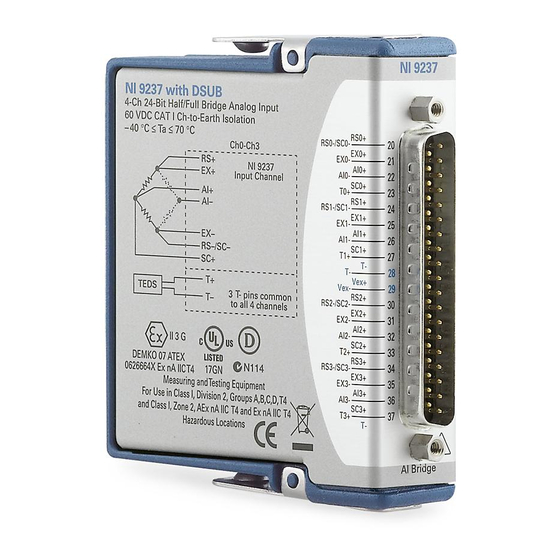
Table of Contents
Advertisement
Quick Links
Advertisement
Table of Contents

Summary of Contents for NI NI-9237
- Page 1 NI-9237 Getting Started 2022-07-06...
-
Page 2: Table Of Contents
Connecting the NI-9237........ -
Page 3: Overview
NI-9237 Getting Started Overview This document explains how to connect to the NI-9237. In this document, the NI-9237 with RJ-50 and the NI-9237 with DSUB are referred to inclusively as the NI-9237. Note Before you begin, read the NI-9237 Safety, Environmental, and Regulatory Information document on ni.com/manuals... -
Page 4: Safety Guidelines For Hazardous Locations
Safety Guidelines for Hazardous Locations The NI-9237 is suitable for use in Class I, Division 2, Groups A, B, C, D, T4 hazardous locations; Class I, Zone 2, AEx nA IIC T4 Gc and Ex nA IIC T4 Gc hazardous locations;... - Page 5 II 3G and is suitable for use in Zone 2 hazardous locations, in ambient temperatures of -40 °C ≤ Ta ≤ 70 °C. If you are using the NI-9237 in Gas Group IIC hazardous locations, you must use the device in an NI chassis that has been evaluated as Ex nC IIC T4, Ex IIC T4, Ex nA IIC T4, or Ex nL IIC T4 equipment.
-
Page 6: Electromagnetic Compatibility Guidelines
EMC performance is attained. Preparing the Environment Ensure that the environment in which you are using the NI-9237 meets the following specifications. Operating temperature (IEC 60068-2-1, IEC 60068-2-2) -40 °C to 70 °C... -
Page 7: Connecting The Ni-9237
Indoor use only. Note Refer to the NI-9237 Specifications on ni.com/manuals complete specifications. Connecting the NI-9237 The NI-9237 provides connections for four half or full bridges, and an external excitation voltage source. Figure 1. NI-9237 Pinout Ch0 – Ch3 AI– Ch 0 RS–... -
Page 8: Connecting A Full Bridge
You can connect a full bridge to the NI-9237. Figure 2. Connecting a Full Bridge to the NI-9237 You also can connect floating signals to the NI-9237. If you connect floating signals to the NI-9237, NI recommends connecting the EX- signal to the earth ground or shield for better noise rejection. -
Page 9: Connecting A Quarter Bridge
Figure 4. Connecting a Quarter Bridge to the NI-9237 You also can use a quarter bridge with the NI-9237 with RJ-50 if you use the NI 9944 or NI 9945 Quarter Bridge Completion Accessory. Connecting TEDS Sensors You can connect TEDs sensors to the NI-9237. -
Page 10: Where To Go Next
NI product. Product registration facilitates technical support and ensures that you receive important information updates from NI corporate headquarters is located at 11500 N Mopac Expwy, Austin, TX, 78759-3504, USA. ni.com © 2022 National Instruments Corporation.


Need help?
Do you have a question about the NI-9237 and is the answer not in the manual?
Questions and answers